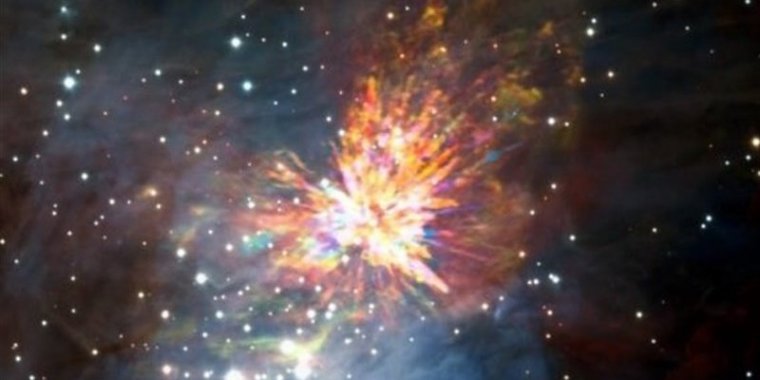| News / Space News |
Dramatic Stellar Fireworks of Star Birth
Astronomers captured a series of dramatic images as they explored the firework-like debris from the birth of a group of massive stars, demonstrating that star formation can be a violent and explosive process too.

Dramatic stellar fireworks of star birth. ![]()
Stellar explosions are most often associated with supernovae, the spectacular deaths of stars. But new observations provide insights into explosions at the other end of the stellar life cycle, star birth.
1350 light years away, in the constellation of Orion (the Hunter), lies a dense and active star formation factory called the Orion Molecular Cloud 1 (OMC-1), part of the same complex as the famous Orion Nebula. Stars are born when a cloud of gas hundreds of times more massive than our Sun begins to collapse under its own gravity.
In the densest regions, protostars ignite and begin to drift about randomly. Over time, some stars begin to fall toward a common center of gravity, which is usually dominated by a particularly large protostar -- and if the stars have a close encounter before they can escape their stellar nursery, violent interactions can occur.
About 100,000 years ago, several protostars started to form deep within the OMC-1. Gravity began to pull them together with ever-increasing speed, until 500 years ago two of them finally clashed.
Astronomers are not sure whether they merely grazed each other or collided head-on, but either way it triggered a powerful eruption that launched other nearby protostars and hundreds of colossal streamers of gas and dust out into interstellar space at over 150 kilometers per second. This cataclysmic interaction released as much energy as our Sun emits in 10 million years.
Fast forward 500 years, and a team of astronomers led by John Bally (University of Colorado, USA) has used the Atacama Large Millimeter/submillimeter Array (ALMA) to peer into the heart of this cloud. There they found the flung-out debris from the explosive birth of this clump of massive stars, looking like a cosmic version of fireworks with giant streamers rocketing off in all directions.
The new ALMA images showcase the explosive nature in high resolution, unveiling important details about the distribution and high-velocity motion of the carbon monoxide (CO) gas inside the streamers. This will help astronomers understand the underlying force of the blast, and what impact such events could have on star formation across the galaxy. (Tasnim News Agency)
YOU MAY ALSO LIKE



